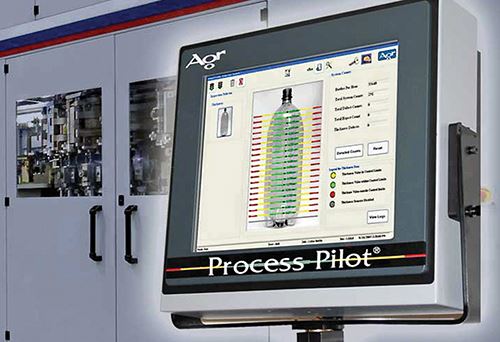BLOW MOLDING: Monitor & Control PET Bottle Crystallinity & Barrier Properties
New QC functions predict shelf-life performance and help optimize physical properties based on crystallinity/orientation.
Two dramatic new additions to online monitoring and control of PET bottle quality were announced at NPE2015 by Agr International, Inc., Butler, Pa. First, Agr has added to its Pilot Profiler in-the-blow-molder thickness-management system for stretch-blown PET bottles. The new function predicts shelf-life performance of the bottle—CO2 and moisture barrier—based on the wall-thickness profile. The math behind the predictive feature is based on the M-Rule container performance model developed by Container Science, Inc., Atlanta. This capability for continuous, nondestructive monitoring of bottle performance can be upgraded to full closed-loop control by adding Agr’s Process Pilot automated blow molding control system to the Pilot Profiler. Process Pilot automatically adjusts machine settings to manage container material distribution to within 0.01 mm.
Another new capability is still in beta testing and is expected to become available as part of Process Pilot in the fourth quarter. Called CrystalView, it addresses crystallinity management as the new frontier in optimizing bottle quality at ever-lighter weights. According to Agr, degree of crystallinity and orientation (two associated properties) are closely correlated with the stretching temperature of the PET preform. For CSD bottles made with the cold-mold process, a cooler preform results in greater orientation during stretching and better bottle performance. On the other hand, stretching a preform that’s too cool results in crazing on the inner surface that correlates with reduced time to stress cracking, an undesirable consequence. Agr’s solution is to monitor pearlescence in the bottle—a sign of crazing—with an electronic camera and adjust the preform temperature to the lowest level above the point of crazing so as to combine highest orientation with longest time to stress cracking.
For heat-set PET bottles made by the hot-mold process, the goal is to maintain dimensional and volumetric stability during hot filling. Higher preform temperatures produce higher crystallinity, but too hot a preform results in crystallinity-induced haze—another undesirable consequence. Agr’s Process Pilot will adjust the preform temperature to the highest level below the hazing point to ensure maximum crystallinity.
Related Content
-
Modified Machines to Mold Unusual PET & PP Bottles at K 2022
K 2022 visitors looking for new ideas in stretch-blown containers will be treated to two novel collapsible concepts a the Nissei ASB booth.
-
All-rPET Bottles with Glued-in Handles Save Material
At K 2022, KHS is showing a 2.3 L PET bottle with glued-in handle that offers 10% material savings and other advantages over clip-in handles. Bottle and handle are both 100% rPET.
-
Krones Acquires Netstal
Krones adds PET preform injection molding to its bottle blowing and filling capabilities, as well as cap molding and expansion into medical, food and other markets.














